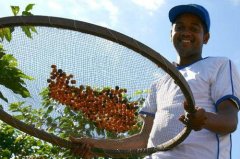Brazilian coffee is the main coffee area, due to the location of Santos, the coffee export port.

Brazil is divided into 26 states, half of which (13) have coffee plantations or farms. But most of the coffee is grown in the southeast of the country, including Bahia, Esp í rito Santo, Minas Gerais, Parana and Sao Paulo. What are the most important coffee producing areas in this country?
Minas Gerais is by far the most important coffee producing state in Brazil because nearly half of the country's coffee production is there. The region's rich soil and high altitude make it the perfect choice for growing the country's most famous specialty coffee. The varieties grown here include Catua í (and Catua í Rubi), Obat ã, Icatu and Mundo Novo.
Minas Gerais is home to four major producing areas:
Cerrado de Minas-Cerrado de Minas has the special distinction that the country is the first to be granted the status of Cerrado Mineiro, which is like coffee equivalent to a famous wine region. The area is high above sea level (800 to 1300 meters), humid in summer, mild and dry in winter, and can produce high-grade specialty coffee. The coffee grown here is more sour and usually falls in between sweetness and the body.
Chapada de Minas-Chapada de Minas has a wide variety of landscapes, and valleys often subdivide the plateau areas of the region. Mechanized production is common throughout the region, and some of the varieties grown here include Catua í and Mundo Novo.
Matas de Minas (Matas de Minas)-located in the Atlantic forest, so most of the area is small farms. The temperature is warm and humid, and the landscape of the area is quite uneven. The region is also known for its budding specialty coffee production. The grapes grown here are usually sweet, with chocolate or caramel flavors.
Sul de Minas-Sul de Minas translates as "south of Minas", with an average altitude of about 1000 meters and a moderate temperature. This combination makes the region an industry hotspot in the state of Minas Gerais-although it is grown on most smaller farms, 30 per cent of the country's coffee is produced in Sul de Minas. Sul de Minas grows a variety of grape varieties, but the flavor characteristics of most of the coffee grown here include fruity aromas, citrus flavors and the whole body.
ESP and RITONANTO
The second largest coffee growing state in the country is also the largest producer of Robusta coffee. But that doesn't mean you won't find any specialty coffee here.
The MontanhasdoEsp í ritoSanto Hotel is located in the highlands, with a mild climate and a medium altitude of 700 to 1000 meters. These conditions enable farmers in the area to export medium and other specialty coffee. The coffee grown here is fruity and highly acidic.
Farther north, the Conilon Capixaba region is famous for growing the Brazilian Robsta of the same name, growing on lower elevations and smaller fields.
Sao Paulo
There are two reasons: it is home to the port of Santos, the country's main coffee export port, and to two areas where quality coffee is grown.
Mogiana-located in the northeast of the state, straddling the border of Minas Gerais, it is one of the most important growing areas in the country. Combined with its famous rich red earth, perfect elevation (9 to 1100 meters), rugged terrain and mild temperature, it can produce high quality coffee such as Catua í and Mundo Novo.
Centro-OestedeS ã oPaulo-the region consists of four cities and is more family-oriented, mainly small and medium-sized farms. Like Mogiana, the area is hilly and rugged.
Bahia
Compared with other regions, Bahia is quite new to the coffee industry because coffee has only been grown here since the 1970s. However, it has become popular for its use of high-quality beans and high-tech agricultural technologies, especially in the Cerrado and Planalto da Bahia areas of the state, where productivity is among the highest in the country.
The area is mostly at higher elevations, with rainy winters and dry summers, which can produce sweeter coffee. 75% of the coffee grown here is Arabica coffee.
Parana.
Parana's Norte Pioneiro area has dense, high-yielding coffee farms. Only Arabica coffee beans are grown here.
Important Notice :
前街咖啡 FrontStreet Coffee has moved to new addredd:
FrontStreet Coffee Address: 315,Donghua East Road,GuangZhou
Tel:020 38364473
- Prev

The History and Geographic location of Brazilian Coffee
The history of Brazilian coffee first came to Brazil in the early 18th century, and in 1727, Portugal commissioned Lieutenant Colonel Francisco de Melo Francisco de Mello Palheta to steal a coffee factory from the then French-controlled nearby territory of French Guiana. Palheta allegedly started growing coffee in Para after smuggling the coffee factory to Brazil.
- Next

The latest version of the 2019 household coffee machine popularity list recommended. How to choose the coffee machine?
Professional coffee knowledge exchange more coffee bean information please follow the coffee workshop (Wechat official account cafe_style) if the coffee in supermarkets and restaurants can no longer satisfy your taste buds, but hope to drink good coffee every day, you might as well buy a coffee machine and keep it at home! With a coffee machine, you can buy coffee beans according to your preference and budget, just press the button to operate.
Related
- Beginners will see the "Coffee pull flower" guide!
- What is the difference between ice blog purified milk and ordinary milk coffee?
- Why is the Philippines the largest producer of crops in Liberia?
- For coffee extraction, should the fine powder be retained?
- How does extracted espresso fill pressed powder? How much strength does it take to press the powder?
- How to make jasmine cold extract coffee? Is the jasmine + latte good?
- Will this little toy really make the coffee taste better? How does Lily Drip affect coffee extraction?
- Will the action of slapping the filter cup also affect coffee extraction?
- What's the difference between powder-to-water ratio and powder-to-liquid ratio?
- What is the Ethiopian local species? What does it have to do with Heirloom native species?

